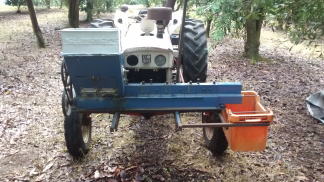
(Click to enlarge. Yes, the belts will be covered in due course.)
In-Field Dehusker
This in-field dehusker is used in tandem with the Drone Harvester. The first version was built last year. This year (2016) it was moved to the front of the tractor where it is more convenient to access and it now runs on 240VAC provided by an on board generator. A bridge-proof hopper was added so that it can be left to process a sample more or less unattended, which in turn means the next sample can be collected while the previous one is being processed automatically.

(Click to enlarge. Yes, the belts will be covered in due course.)
Concurrent harvesting and dehusking saves time not only in the field but also in the simple logistics of handling large numbers of samples.

Trash is left in the field, further reducing the amount of material taken back to the shed.
Currently it is really aimed at dehusking samples in trial plots, but it will be gradually upgraded to automate later post-harvest processing steps (sizing, sorting, trash removal) until the output is more or less ready for immediate sale. Adding these steps will also allow more detailed tree by tree data to be collected, such as tree by tree reject analysis.
Further work will be done to automate the transfer of nuts from the drone to the dehusker which is done manually at the moment.
This year (2016) it will be used for the bulk of the main harvest to test
it thoroughly before the upgrades.
The video below shows the dehusker working with the new non-bridging hopper. It has worked out quite well, though getting the feed rate of the hopper right was a bit tricky - too slow and it can't keep up with incoming samples and leaves can build up, too fast and it can over-feed the dehusker leading to jamming.
Overall it bridges very rarely but it still jams with a stick occasionally, jam detection will probably be added in the near future so it can try reversing etc before shutting down and waiting.
The first version was built last year so we could get trial plot nut-in-shell (NIS) weights on the spot. This saved the fairly significant task of bagging, labeling, de-bagging, processing samples for each plot; instead we could just do the processing immediately in the field and then put the resulting product straight into a bulk bin.
This version mounted on the three point linkage of a tractor and was driven by the remote hydraulics. The feed area of the hopper was lengthened to reduce bridging which helped a bit but still tended to bridge.
Copyright © 2016 David Bell, Australia. All
Rights Reserved.
No parts of this web site may be copied without the
permission of the author.